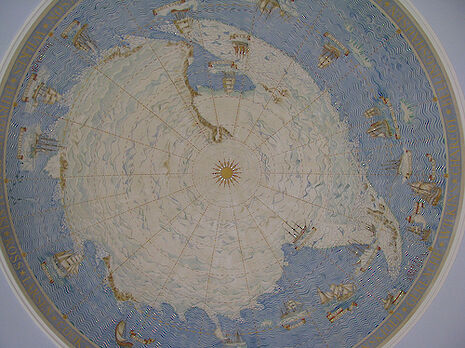Mad About Museums: The Polar Museum
In the next installment of the series, Lucy Meekley uncovers the secrets of The Polar Museum

The Polar Museum was founded in 1920 as a memorial to Captain Robert Falcon Scott. It showcases discoveries about the life and science of the Antarctic and Arctic regions, and the expeditions that made them possible.
We are reminded of the sacrifices of these explorers at every step around the museum. On the wall of the entrance hall is a harrowing quote from Scott’s journals which reads “These rough notes and our dead bodies must tell the tale.” However, it is also a celebration of their lives, achievements and their legacy.
In the entrance hall be careful not to miss the two wonderful ceiling domes painted by Macdonald Gill. Trickier to miss is the sledge made entirely from picture frames whichfills one half of the lobby in honour of the museum’s current temporary exhibition Landscapes of Exploration, which explores artistic interpretations of Antarctica.
Inside, several cases display objects from the lives of people living in the Arctic. I was particularly taken by the collection of animal figures which included an arctic crane, beautifully made using a Muskox horn, and an ivory scene of miniature animals, men and sledges. These serve to remind us that the Arctic is not the uncultivated wasteland it is often imagined to be.
The displays then shift their focus onto the explorers. One of the most impressive objects is a barrel organ (described as “the iPod of its day”) taken by William Parry on his voyage to find the North West Passage, as a means of entertainment. There is an impressive assortment of scrimshaw from whaling fleets, who would carve images, such as ships and women, into the bones and teeth of whales.
The museum holds various objects which Scott took with him on his two major Antarctic voyages, including his personal camera. The pictures developed from the camera have only recently been received by the Scott Polar Research Institute. They offer a fascinating insight into the conditions and activities on their voyage.
The final room of the museum contains the aforementioned Landscapes of Exploration exhibition, which will be on display until 16th November. The work comes from the ten artists and one musician who undertook residencies in the Antarctic between 2001 and 2009 and explores themes such as discovery and isolation. The museum is also working on a poetry project drawing inspiration from the polar districts.
It is this this desire to engage with, and engage others with, the museum which makes it so successful. It combines its roles as a research institution and museum brilliantly, constantly working on original ways to interpret and display the researchers’ work.
 News / SU reluctantly registers controversial women’s soc18 December 2025
News / SU reluctantly registers controversial women’s soc18 December 2025 Features / Should I stay or should I go? Cambridge students and alumni reflect on how their memories stay with them15 December 2025
Features / Should I stay or should I go? Cambridge students and alumni reflect on how their memories stay with them15 December 2025 News / Dons warn PM about Vet School closure16 December 2025
News / Dons warn PM about Vet School closure16 December 2025 News / Cambridge study finds students learn better with notes than AI13 December 2025
News / Cambridge study finds students learn better with notes than AI13 December 2025 Comment / The magic of an eight-week term15 December 2025
Comment / The magic of an eight-week term15 December 2025








